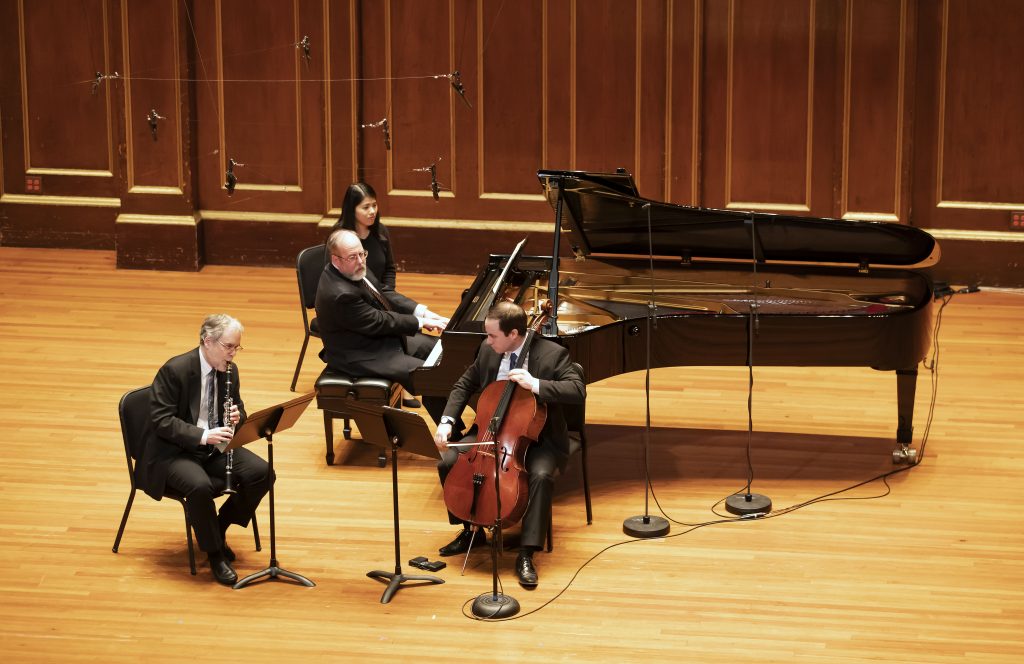Broken string mid-Brahms doesn’t faze Boston Chamber Players

Before his death in 1942 in a Nazi concentration camp, composer Erwin Schulhoff made the kind of cutting-edge music that his tormentors would label as degenerate: modernistic works in the 1920s and 1930s reflecting jazz idioms and even Dadaist techniques.
Yet Schulhoff was also a creator of rugged classical landscapes. His Concertino for flute, viola, and double bass draws upon folk sources from his native Czechoslovakia. Equal parts pastorale and driving dance piece, this score from 1925 remains one of Schulhoff’s most intriguing chamber works. Sunday afternoon at Jordan Hall, the Boston Symphony Chamber Players reminded audiences why that is the case.
With smooth tone and crackling energy, the Chamber Players mined the score for its rustic beauty and fervor. Bassist Edwin Barker and violist Steven Ansell unfolded the opening movement’s octaves in gentle arcs as flutist Elizabeth Rowe floated a melody that twisted in chromatic knots.
While an air of mystery characterized the third movement, its lines overlapping without firm resolution, the second and fourth movements showcased the musicians in moments of power and drive. Crisply rendered, the Furiant had the clarity and sizzle of a movement from Stravinsky’s L’Histoire du soldat. The theme transformed into a zesty dance in the finale, which the musicians rendered with the verve of a village band.
Bohuslav Martinů’s Nonet for winds and strings, also heard on Sunday’s program, bears a similar zeal. Performances of this score tend to be rather cold and objective, but the Chamber Players imbued it with a radiant expressiveness and orchestral depth.
The Poco Allegro had the dimensions of a symphonic movement, brimming with solos that rose easily to the surface of Martinů’s textures. That dynamic carried into the Andante, where cellist Blaise Déjardin passed a phrase to bassoonist Richard Svoboda and oboist John Ferrillo, the music ultimately flowering in the full ensemble. With its burbling figures, the final Allegretto brought the performance to a bold conclusion.
Before the Martinů, violinist Haldan Martinson offered selections from György Kurtág’s Signs, Games, and Messages, works that involve a variety of instrumental colors.
Styles that recall Bach and Ligeti are apparent in these short, often gestural, works. Two movements entitled “Perpetuum mobile” are essentially classical in-jokes, using silences and sudden forte passages to interrupt the violin’s arpeggios. “Anziksz Kellerannának” transforms dissonances into a swift dance, which bounds before stopping suddenly. “Panaszos nóta” is little more than a single note that wavers before sliding into glassy harmonies.
Here and elsewhere in the set, Martinson played with precision and conviction. “The Carenza Jig” showcased him in deft fiddling, while “Kromatikus feleselös” featured timbres that were by turns scratchy and shimmering.
The phrases of “… féerie d’automne” seemed to glow at a distance on Martinson’s muted instrument. The crux of the set was “Antifóna Hirominak,” which spotlighted the violinist in a bold display of triple stops and surging lines.
The Chamber Players followed intermission with trios by Carl Reinecke and Johannes Brahms.
Reinecke’s Trio in A minor for oboe, French horn, and piano hails embodies a grace and clarity that were well captured on Sunday. Ferrillo, hornist Richard Sebring, and pianist Benjamin Pasternack played it with such subtlety and sweep, it left one to wonder why this work from 1887 has fallen into obscurity.
Pasternack’s rollicking piano figures created a sense of spaciousness in the first movement, which Ferrillo and Sebring peppered with robust statements. The tempo lingered, with the players emphasizing the marked moderato. But the music they produced was thoroughly warm and inviting, even in the moments of tension and release.
Sebring and Ferrillo complemented Pasternack’s flowing lines for brisk, playful dialogue in the Scherzo. The ensuing Adagio took on the sweep of an operatic aria in Sebring’s soaring horn phrases. The finale elicited playing of grandeur and serenity.
Brahms’s Trio in A minor for clarinet, cello, and piano, was Sunday’s finale, and critics have long derided it as the lesser of his four chamber scores. Yet it bears attractive lyrical richness and dramatic intensity in its half-hour length.
After Pasternack and cellist Déjardin offered a soulful introduction, the music surged intently, providing a backdrop for William R. Hudgins’s silky clarinet phrases.
Hudgins and Déjardin were simpatico partners in the Adagio, trading lines over Pasternack’s trickling accompaniment. Midway through, Déjardin broke a string, halting the performance. When he returned to the stage — restrung cello in hand — the musicians picked up where they left off, recapturing their uniform warmth and vitality.
In the heightened intensity of the last movements, the Andante showcased the musicians in sprightly dialogue, and the final Allegro saw bold statements give way to yearning phrases that brought the concert to a fervent conclusion.
The Boston Symphony Chamber Players will perform music by Puts, Nathan, Smyth, and Mendelssohn 3 p.m. March 22 at Jordan Hall. bso.org; 888-266-1200
Posted in Performances